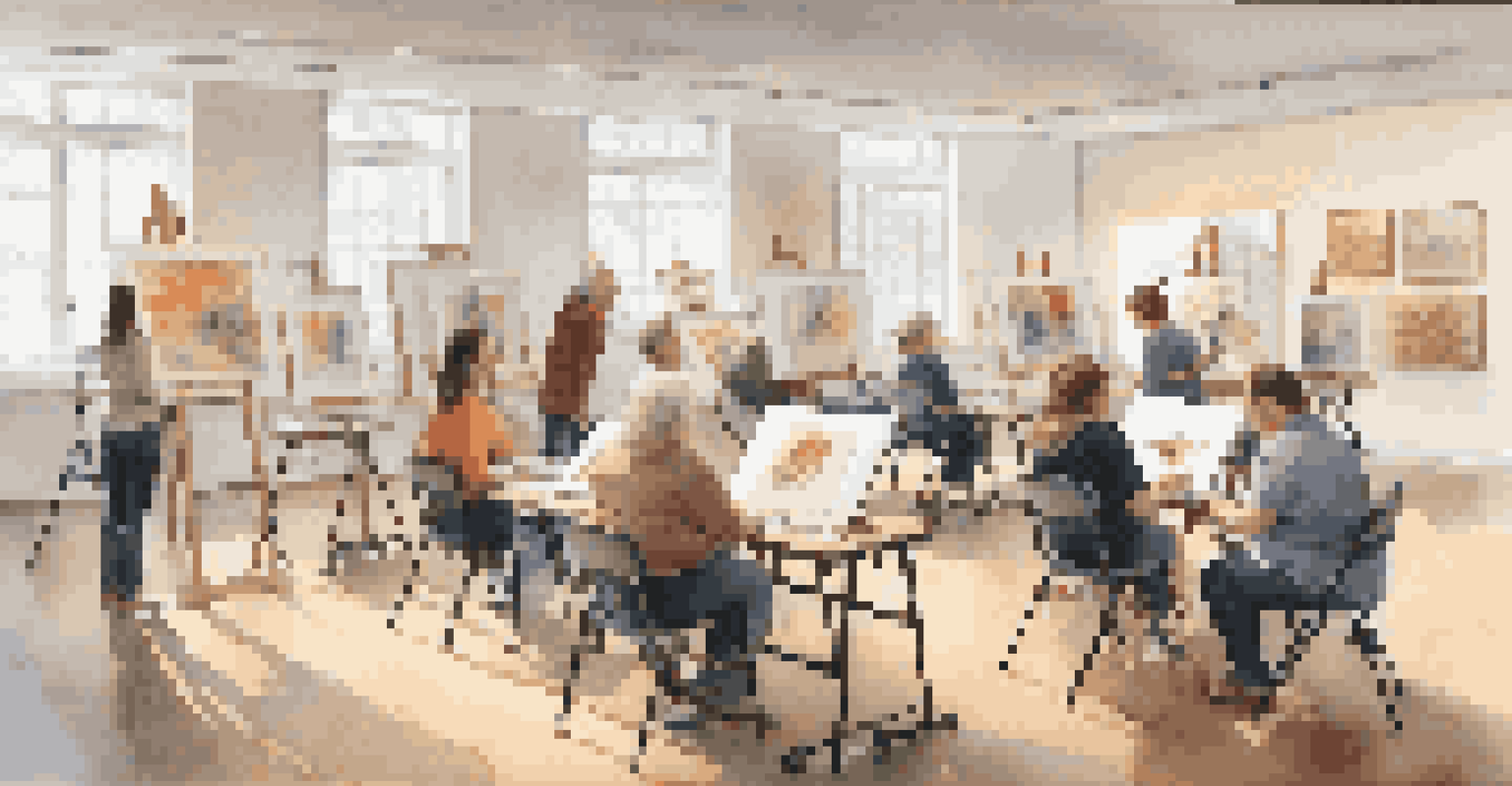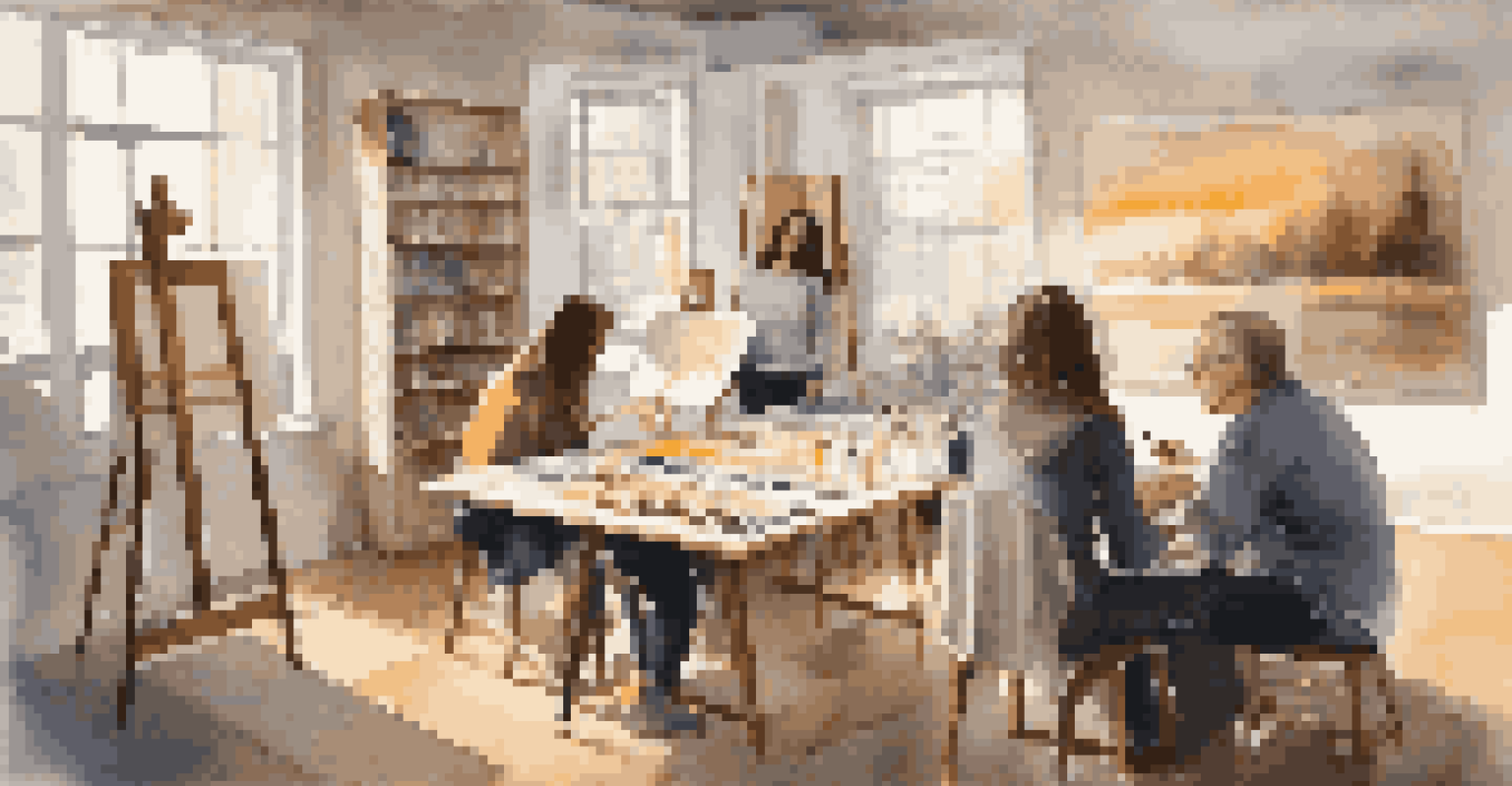Creating Inclusive Art Spaces: Challenges and Solutions

Understanding the Importance of Inclusive Art Spaces
Inclusive art spaces are crucial for fostering creativity and expression among diverse communities. They allow individuals from various backgrounds and abilities to share their perspectives and talents, enriching the artistic landscape. When everyone feels welcome, art becomes a powerful tool for connection and understanding.
Art is a way of expressing ourselves and bringing people together. It is through inclusivity that we can amplify diverse voices and perspectives.
Moreover, inclusive art spaces help break down social barriers, encouraging collaboration and dialogue among participants. This diversity not only enhances the quality of art produced but also deepens the impact it has on audiences. Ultimately, an inclusive environment cultivates a sense of belonging and validation for all artists involved.
However, creating such spaces requires a commitment to understanding and addressing the unique needs of different groups. This involves actively seeking out voices that have been historically marginalized, ensuring that their experiences are represented and valued in the art world.
Identifying Common Challenges in Inclusivity
Despite the clear benefits, there are several challenges that organizations face when striving for inclusivity in art spaces. One significant hurdle is the lack of awareness or understanding of what inclusivity truly means. Many may think they are being inclusive simply by allowing diverse participation, but genuine inclusivity requires deeper engagement.

Another challenge is resource limitations. Many art spaces operate on tight budgets, making it difficult to implement programs or facilities that cater to everyone’s needs. This can lead to unintentional exclusion, particularly for individuals with disabilities or those from lower socioeconomic backgrounds.
Importance of Inclusive Art Spaces
Inclusive art spaces enrich creativity by valuing diverse perspectives and fostering a sense of belonging among artists.
Additionally, there may be resistance to change from within the organization. Some staff or community members might question the need for inclusivity initiatives, fearing that it may dilute the quality of the art or alienate existing patrons. Addressing these concerns and fostering a culture of openness is essential for moving forward.
Creating Accessible Physical Spaces
One of the first steps in fostering inclusivity is ensuring that physical art spaces are accessible to everyone. This includes modifications for individuals with disabilities, such as wheelchair ramps, accessible restrooms, and clear signage. By addressing these practical needs, organizations can create a welcoming environment for all visitors.
Diversity is not about how we differ. Diversity is about embracing one another's uniqueness.
However, accessibility doesn't stop at physical structures; it also encompasses the layout and design of workshops and exhibitions. Thoughtful arrangement of art displays and workstations can enhance engagement for individuals with different sensory or mobility needs. For instance, providing quiet zones or tactile materials can cater to those who may feel overwhelmed in a bustling environment.
Furthermore, ongoing evaluation and feedback from community members can guide improvements in accessibility. By inviting artists and participants to share their experiences, art spaces can continually adapt and ensure that they meet the needs of their diverse audience.
Developing Inclusive Programming and Workshops
Inclusive art programming is vital for engaging a diverse audience. This means designing workshops that cater to various skill levels, interests, and cultural backgrounds. For example, offering classes in different art forms—from painting and sculpture to digital media—ensures that everyone can find something that resonates with them.
Moreover, incorporating diverse cultural perspectives into programming can enrich the experiences of all participants. Collaborating with artists from different backgrounds can introduce new techniques, stories, and approaches to creativity. This not only elevates the quality of the programming but also fosters a sense of community among participants.
Challenges to Achieving Inclusivity
Organizations face hurdles like limited resources and resistance to change when striving for genuine inclusivity in art spaces.
Additionally, creating mentorship opportunities can further support inclusivity. Pairing experienced artists with newcomers can help build confidence, provide guidance, and encourage collaboration across various skill levels.
Engaging Underrepresented Communities
To create truly inclusive art spaces, it's essential to actively engage with underrepresented communities. This means reaching out to individuals who may not typically have access to art programs or feel marginalized in traditional art settings. Building relationships with community organizations can facilitate these connections and encourage participation.
Listening to the needs and desires of these communities is crucial. Conducting surveys, hosting focus groups, or simply having conversations can provide valuable insights into what individuals want from an art space. This feedback can guide programming and ensure that it reflects the community's unique culture and perspectives.
Additionally, showcasing the work of artists from these communities can empower them and inspire others. By providing platforms for underrepresented voices, art spaces can contribute to a richer, more diverse artistic dialogue.
Building a Culture of Collaboration and Support
Creating inclusive art spaces is not just about policies and programs; it's about cultivating a culture of collaboration and support. This means encouraging artists and participants to share their ideas, experiences, and challenges openly. When individuals feel that their voices are valued, they are more likely to engage and contribute to the community.
Mentorship and peer support can play a significant role in building this culture. By fostering connections between established artists and emerging talents, art spaces can create an environment where everyone feels encouraged to grow and learn from one another. This collaborative spirit can lead to innovative projects that reflect the diversity of the community.
Engaging Underrepresented Communities
Actively reaching out to and listening to underrepresented communities is essential for creating truly inclusive art environments.
Moreover, celebrating achievements—big and small—can enhance this culture of support. Acknowledging the contributions of all artists helps foster a sense of pride and belonging, making everyone feel like an integral part of the artistic journey.
Measuring Success and Ongoing Improvement
Finally, it’s essential to measure the success of inclusivity efforts and make necessary adjustments. This involves setting clear goals and benchmarks for what inclusivity looks like in the context of the art space. Regularly assessing these goals can provide insights into areas that may need more attention or resources.
Collecting feedback from participants can also inform ongoing improvements. Surveys, interviews, or informal discussions can uncover valuable perspectives on how inclusive the space truly feels. This information can guide future programming and initiatives, ensuring that they align with the community's needs.

Ultimately, inclusivity is an ongoing journey rather than a destination. By remaining flexible and responsive to feedback, art spaces can continue to evolve and provide enriching experiences for everyone involved.